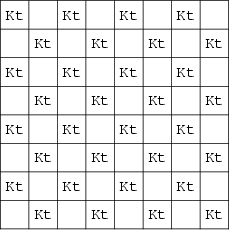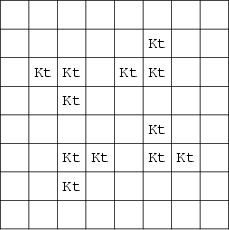|
|
|

The problem of determining how many nonattacking knights ![]() can be placed on an
can be placed on an ![]() Chessboard. For
Chessboard. For ![]() ,
the solution is 32 (illustrated above). In general, the solutions are
,
the solution is 32 (illustrated above). In general, the solutions are

The minimal number of knights needed to occupy or attack every square on an ![]() Chessboard is given by
1, 4, 4, 4, 5, 8, 10, ... (Sloane's A006075). The number of such solutions are given by 1, 1, 2, 3, 8, 22, 3, ...
(Sloane's A006076).
Chessboard is given by
1, 4, 4, 4, 5, 8, 10, ... (Sloane's A006075). The number of such solutions are given by 1, 1, 2, 3, 8, 22, 3, ...
(Sloane's A006076).
See also Bishops Problem, Chess, Kings Problem, Knight's Tour, Queens Problem, Rooks Problem
References
Dudeney, H. E. ``The Knight-Guards.'' §319 in Amusements in Mathematics. New York: Dover, p. 95, 1970.
Madachy, J. S. Madachy's Mathematical Recreations. New York: Dover, pp. 38-39, 1979.
Moser, L. ``King Paths on a Chessboard.'' Math. Gaz. 39, 54, 1955.
Sloane, N. J. A. Sequences
A030978,
A006076/M0884
and A006075/M3224
in ``An On-Line Version of the Encyclopedia of Integer Sequences.''
http://www.research.att.com/~njas/sequences/eisonline.html and extended entry in Sloane, N. J. A. and Plouffe, S.
The Encyclopedia of Integer Sequences. San Diego: Academic Press, 1995.
Vardi, I. Computational Recreations in Mathematica. Redwood City, CA: Addison-Wesley, pp. 196-197, 1991.
Wilf, H. S. ``The Problem of Kings.'' Electronic J. Combinatorics 2, 3 1-7, 1995.
http://www.combinatorics.org/Volume_2/volume2.html#3.